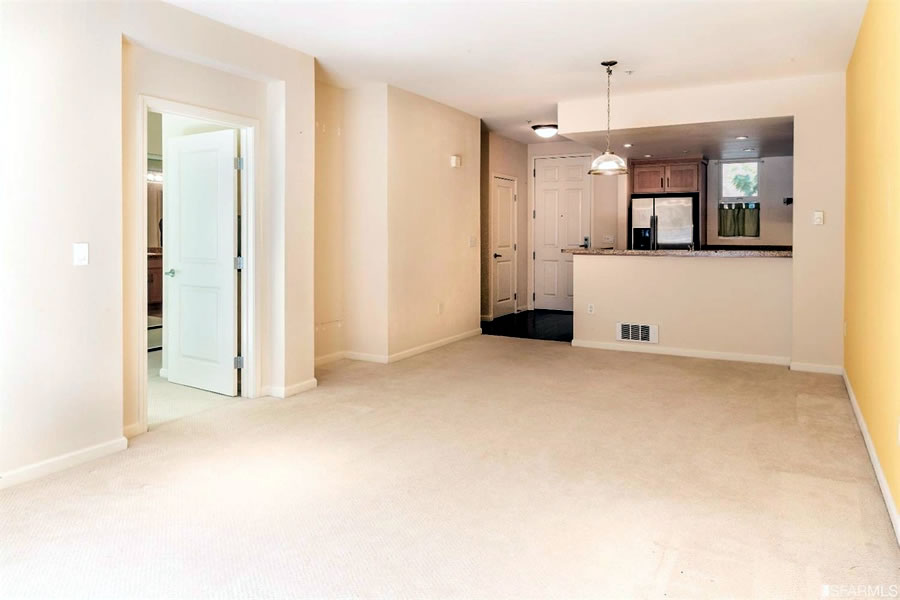Purchased as new for $330,000 in 2007, or roughly $409 per square foot, as part of San Francisco’s inclusionary (a.k.a. Below Market Rate or Affordable) housing program, the 807-square-foot, one-bedroom condo #4201 at Candlestick Cove returned to the market listed for $450,626 ($558 per square foot) six months ago, representing the maximum allowed increase under the Mayor’s program and an adjustment for an increase in the Area Median Income (AMI) over the past decade.
Available to buyers with an individual income of up to $90,500 or a household income up to 120 percent of the AMI, which is $103,400 for a household of two, the condo remains empty and available with a price which was reduced to $395,000 ($489 per square foot) two weeks ago.
The monthly homeowner dues of $361 per month for the unit include a deeded parking space.






Could it be that families making under $90k are too broke to even afford these lower income units? A recent study found 31% of Americans couldn’t write a $500 check to cover an emergency expense. Survey after survey is showing similar struggles for the regular Joe. Then there’s that crazy student loan debt for millennials…
The bigger problem is getting a loan. As was explained to me, buyers must go on the private market to get a loan, but with strictly limited income and under a time table.
Yeah the banks are being really tight with the money these days, b-b-because the mainstream media says so. Meanwhile in Realityville, among first-time homebuyers who obtained a mortgage in Dec 2016–Feb 2017, 80% made a downpayment of less than 20%.
Banks have tightened up and become more highly regulated. And as a result, they’ve dramatically lost market share to non-bank lenders: “In 2011, 50 percent of all new mortgage money was loaned by the three biggest banks in the United States: JPMorgan Chase, Bank of America and Wells Fargo. But by September 2016, the share of loans by these three big banks dropped to 21 percent.”
It’s not about banks and down payments in general. The problem is that people with strict income limits have to find a lender able to pay for the mortgage.
While you might make a case for BMR rental units, I have never understood the arguments for BMR “ownership.” Anyone who qualifies for a loan for this still needs to have a pretty good income (it’s not like this is housing for the poor) and, at the end of the day, you don’t really own something that is subject to price controls. This whole stupid program should be abolished.
First off, all homeowners are subsidized by the govt, even the richest, via the mortgage interest deduction. The goal of SF’s BMR ownership program is to give median-income folks entry into an impossible market (for different buildings, the income requirement ranges from 80%-120% of AMI I believe). People who qualify can arguable afford a mortgage, but not in SF’s inflated / restricted building market.
Larger question is whether this captures enough of the median income level, since folks making 120% probably can’t afford a down payment on a market rate home…but then again, the city also has the DALP program (downpayment assistance) for folks buying their first home.
Even if you can stretch enough to buy the property, you’re still facing the Bay Area cost of living for everything else.
The cost of living is one of the reasons up to 40% of millennials are thinking of relocating out of the area in the next few years. Per the Bay Area Council poll IIRC.
The Bay Area and especially SF may have waited too long to address this problem. Whether it be rental or owner BMR units, we are at the point where there are not resources/ways to create enough affordable middle class housing to put a dent in the problem.
Kudos to Seattle which is pursuing an aggressive affordable housing program (40% of the 40K plus new units planned by 2025) at a time when that city is significantly more affordable than SF. Taking on the problem relatively early gives them the leeway to make a real difference and hopefully avoid an SF style housing crisis. .
Seattle/Portland are ahead of the curve compared to SF and the Bay Area, but the huge influxes of new residents are taking a toll on infrastructure and jacking up the costs of existing housing stock.
Sometimes I get the feeling that Dave is posting from his office at the Seattle Chamber of Commerce.
Seattle is less than half as densely built as SF. So while I think we need to build more densely in SF, I certainly hope it is easier to add housing in Seattle.
And yet here’s a condo, with parking, which didn’t move at the below market rate price of $450K.
The problem is getting a loan for that on a limited income.
Before you pack up and move to Seattle, remember they are light years behind SF in terms of transportation infrastructure. Last time I checked, money trees had been clear cut.
I don’t consider a tax deduction a “subsidy,” but you may differ. I do favor getting rid of this deduction in exchange for lowering the tax rates. In any case, anyone paying cash does not get this benefit.
The fact remains that this is sort of welfare program for the Upper Middle Classes. And not many people really benefit.
If you consider a tax deduction to be a “subsidy”, you have to assume all the money someone makes actually belongs to to government. Tax breaks are not the same as the government paying for your subsidy !
Uh, yeah, a tax break is a subsidy since it encourages spending by lowering the cost: The mortgage interest deduction is *definitely* a welfare program for the middle class, though it disproportionately benefits the wealthiest.
Do you believe that if the government taxed you at 95%, and then reduced that to 50%, you would be getting either “welfare” or a subsidy?
@ Mark F: If your tax bracket is set by law at 95% and you get nearly half of that back through government programs, then YES you are getting a subsidy, also known as “welfare.”
Rich people don’t like to call it this (or acknowledge such programs as welfare), because the public/politicans can keep pretending that programs for the poorest are eating up all our precious tax dollars, when in reality, it’s tax breaks on the wealthy that give away the most. Read that Nation article for more detail.
A tax break is “the same as the government paying for your subsidy.” It is no different from paying the full tax and then the government cutting you a check in the amount of the tax break. Koch Bros. word games aren’t going to work for you here. More money in your pocket and less in the government’s either way.
Sara, tax breaks are indeed a subsidy because if you get a tax break, it means SOMEONE ELSE is paying more taxes to pay for your tax break, and that is a subsidy. And, taxes you owe do belong to the government, just like a credit card debt belongs to your creditor. So, if you get a credit against your liability, you are gettiing a subsidy.
the program has dumb rules that penalize you for having savings. Someone who doesn’t earn much but diligently saved his income over the years could become disqualified from buying a unit, whereas the next guy who might have actually have a wealthier income but blew all his money on toys, would qualify. more perverse incentives and punishing good behavior by the government.
Are there any public disclosures about SF’s BMR? How many units are part of it, any transactions that take place, how the acceptable rates of increase in price are calculated, etc.
In addition, is there any auditing or oversight that takes place? How does the city ensure that people aren’t buying BMR units and then renting them out at market rates?
Finally, is there any sort of sunset plan on the BMR program or is it designed to last ad infinitum? It seems ill planned to have set up the program in such a way that it must be monitored forever, but I guess that wouldn’t be too surprising given that I don’t find much of the program very well thought out…
Since it’s a city program, I’m sure there is lots of public info you can access. I’d start by looking through the docs on the BMR website.
Let’s say you finance the whole thing, interest only, 4%, you’re looking at $1661 in interest & HOA. Add in insurance, maintenance, property tax and you’re probably around $2000/month at least, probably more including PMI. For that, I’d probably want something like this instead, much less hassle, much better neighborhood IMHO.
And, while such loans are common for much more expensive homes, would lenders ever consider that for a middle income first-time-home-buyer?
Are you asking if lenders ever give loans out for homes less than 500K / people making less than median income? Because, yes, obviously they do.
He probably means do they give 4% down, IO loans or the like for this type of property.
Right. More specifically $0 down, 4% interest. The assets required for a substantial down payment might disqualify a buyer from the program. An amortized loan might put the payments out of reach for someone at that income. My point is that the restrictions on income don’t seem to match the asking price. Right?
I am going to venture a guess that the apartment’s not moving because it’s in candlestick cove, not because nobody can afford it. There is literally nothing around there and you would need to a car to get anywhere useful. The Third line isn’t even that accessible from there due to the hill. Commute time from there to downtown would be the same as many other parts of the peninsula with better access to BART and/or caltrain. It seems to me like a not very attractive place to live. Maybe that will change once the rest of candlestick gets developed. Even then, not sure the area will be dense enough to create a real neighborhood.
BMR is simply a bad investment. There is no appreciation. Who in the right mind wants to invest in something that does not appreciate in value? There are so many rent-controlled apartments in SF. Why bother buying BMR? RENT a rent-controlled apartment!
A couple of things to keep in mind:
1. BMR condos can appreciate in value and typically do, albeit at a restricted rate
2. Mortgage payments for a BMR condo are tax deductible
3. Accumulated equity, via a paid-down principal balance, can be cashed out when a unit is sold
In effect, it’s a forced savings account and hedge against inflation, as is most real estate when the market isn’t booming. And in fact, BMR units can outperform market-rate units in San Francisco when the market is on the decline.
Because paying rent is building negative equity.
Not in San Francisco, Brahma, you should know that. Estate for life.